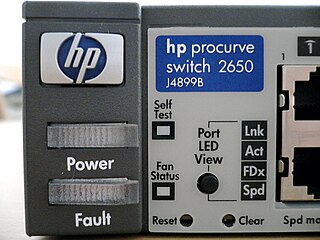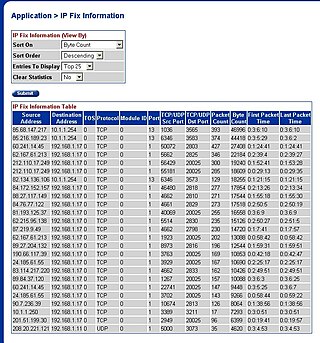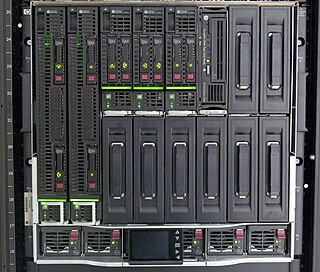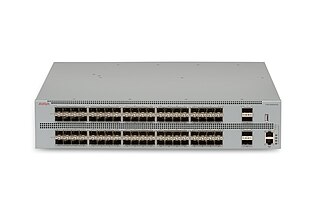Related Research Articles

3Com Corporation was an American digital electronics manufacturer best known for its computer network products. The company was co-founded in 1979 by Robert Metcalfe, Howard Charney and others. Bill Krause joined as President in 1981. Metcalfe explained the name 3Com was a contraction of "Computer Communication Compatibility", with its focus on Ethernet technology that he had co-invented, which enabled the networking of computers.
A network switch is networking hardware that connects devices on a computer network by using packet switching to receive and forward data to the destination device.
Brocade Communications Systems, Inc., was an American technology company specializing in storage networking products, now a subsidiary of Broadcom Inc. The company is known for its Fibre Channel storage networking products and technology. Prior to the acquisition, the company expanded into adjacent markets including a wide range of IP/Ethernet hardware and software products. Offerings included routers and network switches for data center, campus and carrier environments, IP storage network fabrics; Network Functions Virtualization (NFV) and software-defined networking (SDN) markets such as a commercial edition of the OpenDaylight Project controller; and network management software that spans physical and virtual devices.

HP ProCurve was the name of the networking division of Hewlett-Packard from 1998 to 2010. The name was associated with the products the company sold. The name of the division changed to HP Networking in September 2010, after HP bought 3Com Corporation.

The Ethernet Routing Switch 5500 Series or is a series of stackable, Layer 3 switches used in computer networking. The ERS 5000 was originally designed by Nortel and is now manufactured by Avaya. Up to 8 ERS 5000 Series Switches may be stacked in a 640 Gbit/s fast stacking configuration. This Switch was used as the access layer device for the 2010 Winter Olympics games. The 817 Access Switches supported 8782 Voice-over-IP telephones.
The Cisco Nexus series switches are modular and fixed port network switches designed for the data center. Cisco Systems introduced the Nexus Series of switches on January 28, 2008. The first chassis in the Nexus 7000 family is a 10-slot chassis with two supervisor engine slots and eight I/O module slots at the front, as well as five crossbar switch fabric modules at the rear. Beside the Nexus 7000 there are also other models in the Nexus range.

BladeSystem is a line of blade server machines from Hewlett Packard Enterprise that was introduced in June 2006.
IEEE 802.1aq is an amendment to the IEEE 802.1Q networking standard which adds support for Shortest Path Bridging (SPB). This technology is intended to simplify the creation and configuration of Ethernet networks while enabling multipath routing.

Accton Technology Corporation is a Taiwanese company in the electronics industry that primarily engages in the development and manufacture of networking and communication solutions, as an original equipment manufacturer (OEM) or original design manufacturer (ODM) partner. Accton has manufacturing plants in Taiwan (Hsinchu), China (Shenzhen), and Vietnam, supported by research and development centers in Taiwan, Shanghai, and California. Its product include 100G, 400G, and 800G switches designed for data center applications, along with wireless devices and artificial intelligence acceleration hardware.
TRILL is a networking protocol for optimizing bandwidth and resilience in Ethernet networks, implemented by devices called TRILL switches. TRILL combines techniques from bridging and routing, and is the application of link-state routing to the VLAN-aware customer-bridging problem. Routing bridges (RBridges) are compatible with, and can incrementally replace, previous IEEE 802.1 customer bridges. TRILL Switches are also compatible with IPv4 and IPv6, routers and end systems. They are invisible to current IP routers, and like conventional routers, RBridges terminate the broadcast, unknown-unicast and multicast traffic of DIX Ethernet and the frames of IEEE 802.2 LLC including the bridge protocol data units of the Spanning Tree Protocol.
Virtual Cluster Switching (VCS) fabric technology is a Layer 2 proprietary Ethernet technology from Brocade Communications Systems, later acquired by Extreme Networks. It is designed to improve network utilization, maximize application availability, increase scalability, and simplify the network architecture in virtualized data centers.
Hewlett Packard Enterprise Networking is the Networking Products division of Hewlett Packard Enterprise ("HP"). HPE Networking and its predecessor entities have developed and sold networking products since 1979. Currently, it offers networking and switching products for small and medium sized businesses through its wholly owned subsidiary Aruba Networks. Prior to 2015, the entity within HP which offered networking products was called HP Networking.

The Dell blade server products are built around their M1000e enclosure that can hold their server blades, an embedded EqualLogic iSCSI storage area network and I/O modules including Ethernet, Fibre Channel and InfiniBand switches.

Ethernet Routing Switch 3500 series and Ethernet Routing Switch 2500 series or ERS 3500 and ERS 2500 in data computer networking terms are stackable routing switches designed and manufactured by Avaya.
HP Virtual Connect is a virtualization technology created by Hewlett-Packard (HP) that de-couples fixed blade server adapter network addresses from the associated external networks so that changes in the blade server infrastructure and the LAN and SAN environments don’t require choreography among server, LAN, and SAN teams for every task. It brings virtualization to the blade server edge as it extends virtual machine technology. Virtual machine technology moves workloads across virtual machines on a single server. It becomes a challenge when moving virtual machines from one physical machine to another or between data center locations because changes to the LAN and SAN environments require manual intervention by network and storage administrators. By pooling and sharing multiple network connections across multiple servers and virtual machines, Virtual Connect extends the capability of Data Center by allowing physical setup and movement of Virtual Machine workloads between servers and Virtual Machines, transparently from the LAN and SAN infrastructure. Another name for Virtual Connect is PowerConnect Switches.
Virtual eXtensible LAN (VXLAN) is a network virtualization technology that uses a VLAN-like encapsulation technique to encapsulate OSI layer 2 Ethernet frames within layer 4 UDP datagrams, using 4789 as the default IANA-assigned destination UDP port number, although many implementations that predate the IANA assignment use port 8472. VXLAN attempts to address the scalability problems associated with large cloud computing deployments. VXLAN endpoints, which terminate VXLAN tunnels and may be either virtual or physical switch ports, are known as VXLAN tunnel endpoints (VTEPs).

The Avaya Virtual Services Platform 8000 Series, or VSP 8000, is a standalone Ethernet Switch manufactured by Avaya, and intended for use in Campus network and Data Center deployment scenarios.
References
- ↑ "H3C - Products & Solutions - IRF2.0 Technology White Paper". Archived from the original on 2010-10-05. Retrieved 2010-12-15.
- ↑ David Newman (3 March 2003). "XRN Interconnect architecture" . Retrieved 26 June 2014.
- ↑ Stricker, Ben (April 12, 2010). "HP Completes Acquisition of 3Com Corporation, Accelerates Converged Infrastructure Strategy". www.investor.hp.com.
- 1 2 3 "Buyer's Guide: HP's Intelligent Resilient Framework (IRF) put to the test | Computer Weekly". ComputerWeekly.com. Retrieved 2024-08-11.
- ↑ http://h17007.www1.hpe.com/docs/reports/irf.pdf [ bare URL PDF ]
- ↑ only on models with fixed or optional 10G ports
- ↑ HPE 5900 Switch Series, HPE
- ↑ HPE 5920 Switch Series, HPE
- ↑ HPE 5940 Switch Series, HPE
- ↑ HPE 6125XLG Ethernet Blade Switch, HPE
- ↑ HPE FlexFabric 12900E Switch Series, HPE